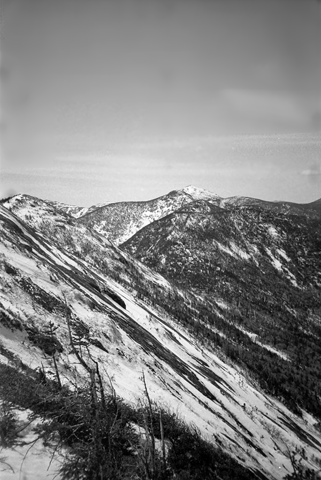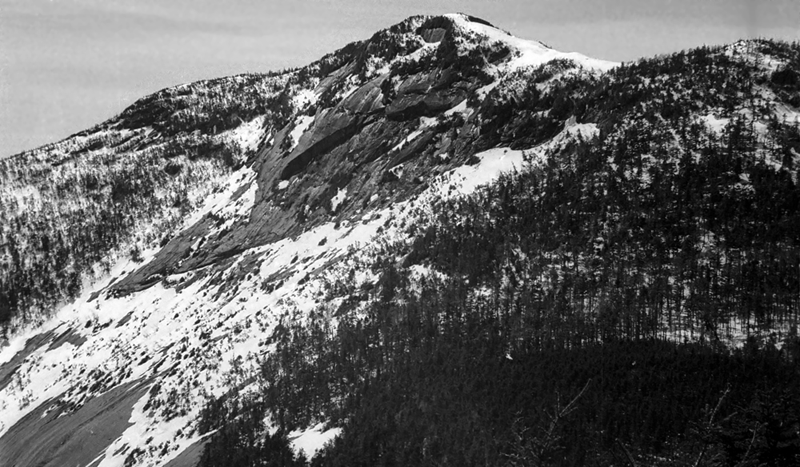The following descriptions concern the discovery, naming, and first ascent information for a few of the Adirondack High Peaks. All of the data and drawings in this article were taken from Russell M. L. Carson’s book, Peaks and People of the Adirondacks, published by the Adirondack Mountain Club in 1927. For all those interested in mountain history, this book is priority material!
As one shall discover, there will always be a debate concerning the actual “first” ascent or “the” accurate name of these mountains. Since both red and white man have inhabited this region, it is certainly a dilemma in choosing between either nations’ claims. As to the nature of things, the conquering nation usually assumes control over recorded history.
Fortunately, some men back in the 1870’s had the insight to record in history both cultures, so that today, we can reflect back and learn some of the truth and history of our Adirondacks.

1) Mount Marcy (5334′, 1626 m.)
In 1837, another geological expedition set out to explore the mountains of New York and try to determine the source of the Hudson River. But those involved also pursued other goals. The leader was Ebenezer Emmons, a professor of Chemistry at Williams College. William Redfield, Archibald McIntyre, David Henderson, and an assortment of other gentlemen completed the group. On August 5, 1837, the expedition set foot on the highest peak enclosed within New York’s boundaries. Emmons, on the summit, stated that the mountain be named after William Marcy, the present governor of New York. From that day on, Emmons was publicly criticized for his christening of this beautiful hill. Many people preferred “Tahawus”, or The Cloud Splitter, the original Indian name.
Nevertheless, the mountain is still the highest in the state and always is the goal of many vistors to the Adirondacks. Various quotes and notes have been recorded about it, but the words of John Cheeney, who was on that first ascent, says it all:
“It makes a man feel what it is to have all creation under his feet. There are woods there which it would take a lifetime to hunt over, mountains that seem shouldering each other to boost the one whereon you stand, up and away Heaven knows where. Thousands of little lakes are let in among them so light and clean. Old Champlain, though fifty miles away, glistens below you like a strip of white birch when slicked up by the moon on a frosty night, and the Green Mountains of Vermont beyond it fade and fade away until they disappear as gradually as a cold scent when the dew rises.”
2) Algonquin (5112′, 1558 m.)
Again we find contraversy over a mountains name. This peak was first recorded as Mount McIntyre, in honor of Archibald McIntyre. He owned and operated the McIntyre Ironworks, as well as serving as a Controller of New York State. The name was documented sometime in 1836 or 1837, but no secure date is known. The first ascent of the mountain occured three days after Mount Marcy, by the same expedition.
The name Algonquin, not McIntyre, was recorded by Verplanck Colvin in his survey reports of 1873. It is the name of the Indian people who first occupied New York’s wild Adirondacks. At a later era, the Iroquois also lived in the region, but moved away to present day Central New York over a quarrel. In the early 1600’s, the combined nations of the Iroquois and Mohawks sided with the English and over a hundred year span, proceeded to exterminate the Algonquin people. Colvin’s naming of Algonquin is certainly a permanent reminder of these once powerful people.
3) Skylight (4920′, 1500 m.)
Unknown to most visitors, Skylight looms high and wild directly south of Mt. Marcy. In 1857, Old Mountain Phelps guided an amateur artist named Frederick Perkins to the Marcy summit. Because many peaks in their panorama were unnamed, they proceeded in a naming duel. On the summit of one, they perceived a rock formation in the shape of a dormer window. It seemed that only one side of the dormer was exposed, while the other simulated a Skylight.
Sixteen years later in 1873, Verplanck Colvin and his survey crew consisting of Professor Charles Peck, 0. S. Phelps, and Roderick McKenzie were the first to record an ascent of this towering peak.

4) Haystack (4918′, 1499 m.)
In August 1849, a trio consisting of Orson (Old Mountain) Phelps, Almerson Oliver, and George Estey made their way to the Marcy summit. Looking up, Phelps mentioned that the mountain to the east looked like a stack of rock, but in its form, it resembled a stack of hay. Many people seemed to avoid Haystack, with all the climbing publicity going to Marcy. It wasn’t until Colvin published his surveys that people noticed both Haystack and Skylight. But even after his notes, these two mountains seemed neglected, with very little travel. Which is odd, because some of the most stunning scenery can be seen from these majestic hunks of rock.
5) Gray Peak (4902′, 1494 m.)
For many years, this mountain was lost in paperwork. It finally appeared on the maps in 1925. The mountain was named for Professor Asa Gray, a noted Harvard botanist. About 1869 it was thought to be named by a state entomologist, Professor J. A. Linter. More notable than the name was the first ascent by Verplanck Colvin and his good friend Bill Nye on September 16, 1872. It was on this day that they also found Lake Tear of the Clouds, source of the Hudson. Colvin’s account of his find, “Discovery of Lake Tear”, can be found in issue four of the AAJ.
6) Whiteface (4872′, 1485 m.)
Of all the high peaks, Whiteface has seen more people on its summit and probably more attention. Its first ascent and the origin of its name is clouded. But it was the first mountain to receive a name. There are records going back to 1813 in reference to Whiteface. There is a couple of Indian names on record, and in translation relate to its present calling. Rumor is that the noted slide with a gray white appearance laid forth the name. The first recorded ascent in 1814 was by a surveyor named John Richards. But no one knows who was the actual first soul to set foot on her summit.
Whiteface is noted for the circumstance known as “Ulloals Rings”, or “Spectre of the Adirondacks”, which was experienced by Peter Schofield in August 1872:
“At the time I was viewing this unique and interesting spectacle, the rising sun was shining from an unclouded sky, and just below the crest of the mountain was a huge,bank of vapor lacking the closer texture of a cloud. Standing between this and a brilliant sun, my shadow, projected upon this background of vapor, was also surrounded and set off by an elongated, oval halo of prismatic hues. This latter effect was due, of course, to the penetration of the vapour drops by the sun’s rays, to the reflection and refraction of these and their final decomposition into their prismatic colours displayed in this rainbow-like exhibit. As I walked along the crest of the mountain, this aerial companion keeping abreast of me imitated my every gesture and movement until, with the breaking up and dissipation of the vapour, it melted away into thin air.”
More recently, Adirondack photographer Nathan Farb has also experienced a similar adventure. Maybe someday soon one of us will be the next lucky individual.
7) Mount Iroquois (4855′, 1489 m.)
As usual, this mountain changed its name a few times. Colvin first called her Mount Clinton, but by 1880 had changed it to Iroquois. Like the naming of Algonquin, Colvin favored the memory of the Indian over the white,man. Between the two peaks, one can find Boundary Peak. It is still not proven fact, but Colvin believed that it was the boundary line between the Iroquois and the Algonquin nations. Whether or not it is true doesn’t really matter, but these two mountains in the McIntyre Range will forever mark the memory of the Indian people. Colvin was the probable first person on Mount Iroquois, but William Brown was recorded to top the summit in October 1883.
8) Dix Mountain (4842′, 1476 m.)
In 1837, Professor Emmons named the mountain to remember John Adams Dix, who was the current Secretary of State. But Emmons never stood on her summit, he only named it as he measured its elevation at 52001, obviously incorrect. At the time, Dix was noted to have been the second highest peak climbed, next to Whiteface. In 1807, a surveyor name Rykert pushed to the top of this massive mountain. Being furthest east of the remaining high peaks, Dix is often forgotten and unseen, except when viewed from Giant or the Great Range. And then one can view one of the most majestic mountains in the region.
9) Basin (4835′, 1474 m.)
On the summit of Marcy, Old Mountain Phelps and the painter Frederick Perkins pondered the view before them. It was 1857 and looking out, they noticed a depression which appeared between the south and west peak before them. So from then on, Basin Mountain it was. Colvin was again the first to stand on her now rocky summit. He and Ed Phelps recorded August 10 , 1877 as the first ascent. But it is known that others were there before, but unfortunately, no records were kept. Basin is surely a beautiful climb and is the central peak of the Great Range.
10) Gothics (4738′, 1444 m.)
Gothics was another of the mountains named by Perkins and Phelps in 1857. Perkins perceived the arched triple peaks with the large slide and exposed rock as Gothic architecture. Since Phelps couldn’t provide a more suitable name, Gothics it became.
Colvin again holds the first ascent. With Roderick McKenzie and Ed Phelps, the summit was achieved on October 11, 1875. Even though it is doubtful that they were the first, Colvin is certainly the winner in describing the ascent of this spectacular peak:
“Before us an irregualr cone of granite, capped with ice and snow, rose againist a wintry sky. The dwarf timber crept timidly upward upon it in a few places, not too steep to find a foothold, and on either side the icy slopes leaped at once down into gloomy valleys. Beyond, irregularly grouped, the great peaks, grizzly with frost and snow, were gathered in grand magnificence. all strange and new in wild sublimity. No sound save the shuddering hiss of the chilly blast as it swept over the fearful ridge of ice that must be our pathway …. Then, with spikeless boots, and no alpenstock save the tripod of the instrument, we essayed the last ascent, the glaring slopes of ice on either side, descending a thousand feet or more, threatened death as a penalty for a single slip.”
